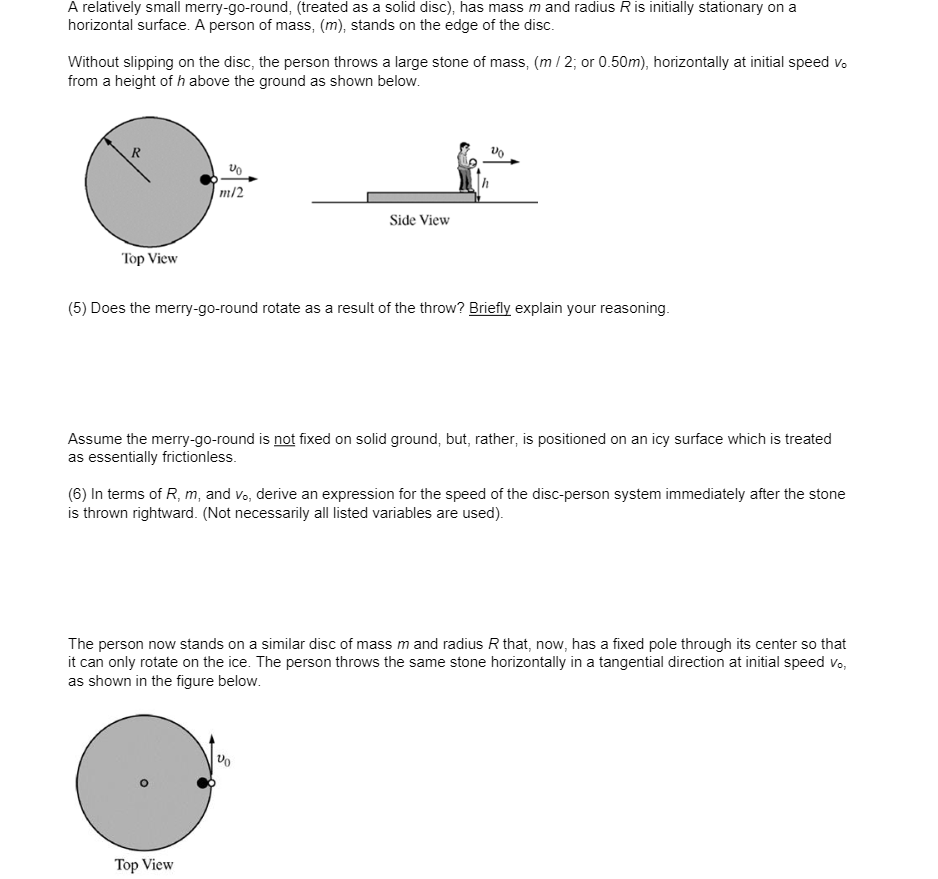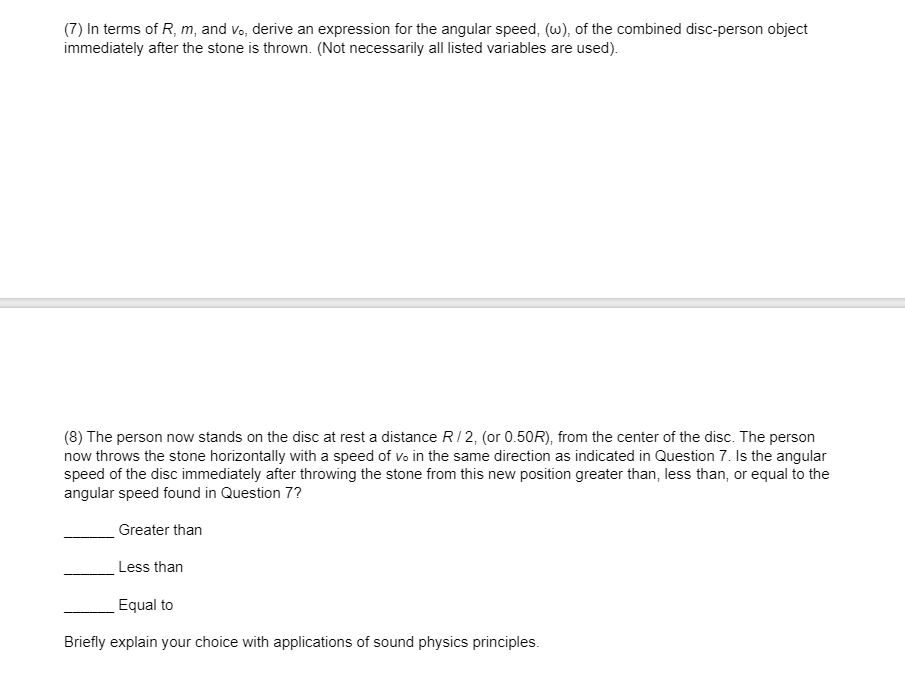(7) In terms of R, m, and vo, derive an expression for the angular speed, (w), of the combined disc-person object immediately after the stone is thrown. (Not necessarily all listed variables are used). (8) The person now stands on the disc at rest a distance RI2, (or 0.50R), from the center of the disc. The person now throws the stone horizontally with a speed of vo in the same direction as indicated in Question 7. Is the angular speed of the disc immediately after throwing the stone from this new position greater than, less than, or equal to the angular speed found in Question 7? Greater than Less than Equal to Briefly explain your choice with applications of sound physics principles.
(7) In terms of R, m, and vo, derive an expression for the angular speed, (w), of the combined disc-person object immediately after the stone is thrown. (Not necessarily all listed variables are used). (8) The person now stands on the disc at rest a distance RI2, (or 0.50R), from the center of the disc. The person now throws the stone horizontally with a speed of vo in the same direction as indicated in Question 7. Is the angular speed of the disc immediately after throwing the stone from this new position greater than, less than, or equal to the angular speed found in Question 7? Greater than Less than Equal to Briefly explain your choice with applications of sound physics principles.
Physics for Scientists and Engineers: Foundations and Connections
1st Edition
ISBN:9781133939146
Author:Katz, Debora M.
Publisher:Katz, Debora M.
Chapter13: Rotation Ii: A Conservation Approach
Section: Chapter Questions
Problem 47PQ
Related questions
Question
I need answers to all the questions within the photos

Transcribed Image Text:A relatively small merry-go-round, (treated as a solid disc), has mass m and radius Ris initially stationary on a
horizontal surface. A person of mass, (m), stands on the edge of the disc.
Without slipping on the disc, the person throws a large stone of mass, (m/ 2; or 0.50m), horizontally at initial speed vo
from a height of h above the ground as shown below.
R
m/2
Side View
Top View
(5) Does the merry-go-round rotate as a result of the throw? Briefly explain your reasoning.
Assume the merry-go-round is not fixed on solid ground, but, rather, is positioned on an icy surface which is treated
as essentially frictionless.
(6) In terms of R, m, and vo, derive an expression for the speed of the disc-person system immediately after the stone
is thrown rightward. (Not necessarily all listed variables are used).
The person now stands on a similar disc of mass m and radius R that, now, has a fixed pole through its center so that
it can only rotate on the ice. The person throws the same stone horizontally in a tangential direction at initial speed vo,
as shown in the figure below.
Top View

Transcribed Image Text:(7) In terms of R, m, and vo, derive an expression for the angular speed, (w), of the combined disc-person object
immediately after the stone is thrown. (Not necessarily all listed variables are used).
(8) The person now stands on the disc at rest a distance RI 2, (or 0.50R), from the center of the disc. The person
now throws the stone horizontally with a speed of vo in the same direction as indicated in Question 7. Is the angular
speed of the disc immediately after throwing the stone from this new position greater than, less than, or equal to the
angular speed found in Question 7?
Greater than
Less than
Equal to
Briefly explain your choice with applications of sound physics principles.
Expert Solution
This question has been solved!
Explore an expertly crafted, step-by-step solution for a thorough understanding of key concepts.
Step by step
Solved in 3 steps with 2 images

Knowledge Booster
Learn more about
Need a deep-dive on the concept behind this application? Look no further. Learn more about this topic, physics and related others by exploring similar questions and additional content below.Recommended textbooks for you

Physics for Scientists and Engineers: Foundations…
Physics
ISBN:
9781133939146
Author:
Katz, Debora M.
Publisher:
Cengage Learning

University Physics Volume 1
Physics
ISBN:
9781938168277
Author:
William Moebs, Samuel J. Ling, Jeff Sanny
Publisher:
OpenStax - Rice University

Physics for Scientists and Engineers: Foundations…
Physics
ISBN:
9781133939146
Author:
Katz, Debora M.
Publisher:
Cengage Learning

University Physics Volume 1
Physics
ISBN:
9781938168277
Author:
William Moebs, Samuel J. Ling, Jeff Sanny
Publisher:
OpenStax - Rice University